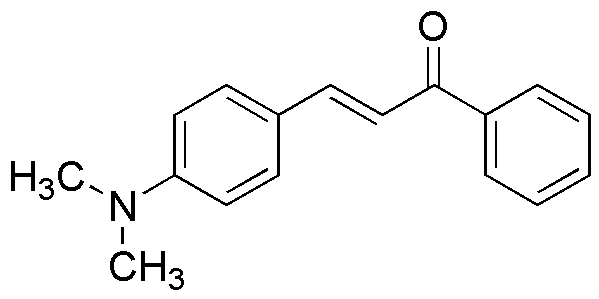4-(Dimethylamino)chalcone is widely utilized in research focused on:
- Organic Synthesis: This compound serves as a versatile building block in organic synthesis, allowing chemists to create complex molecules efficiently.
- Fluorescent Dyes: It is used in the development of fluorescent dyes for biological imaging, enhancing visibility in microscopy and other imaging techniques.
- Pharmaceutical Research: The compound is explored for its potential therapeutic properties, particularly in developing new drugs targeting various diseases.
- Material Science: It finds applications in creating advanced materials, such as organic light-emitting diodes (OLEDs), due to its unique electronic properties.
- Photovoltaic Cells: Researchers are investigating its role in improving the efficiency of organic solar cells, contributing to renewable energy solutions.
General Information
Properties
Safety and Regulations
Applications
4-(Dimethylamino)chalcone is widely utilized in research focused on:
- Organic Synthesis: This compound serves as a versatile building block in organic synthesis, allowing chemists to create complex molecules efficiently.
- Fluorescent Dyes: It is used in the development of fluorescent dyes for biological imaging, enhancing visibility in microscopy and other imaging techniques.
- Pharmaceutical Research: The compound is explored for its potential therapeutic properties, particularly in developing new drugs targeting various diseases.
- Material Science: It finds applications in creating advanced materials, such as organic light-emitting diodes (OLEDs), due to its unique electronic properties.
- Photovoltaic Cells: Researchers are investigating its role in improving the efficiency of organic solar cells, contributing to renewable energy solutions.
Documents
Safety Data Sheets (SDS)
The SDS provides comprehensive safety information on handling, storage, and disposal of the product.
Product Specification (PS)
The PS provides a comprehensive breakdown of the product’s properties, including chemical composition, physical state, purity, and storage requirements. It also details acceptable quality ranges and the product's intended applications.
Certificates of Analysis (COA)
Search for Certificates of Analysis (COA) by entering the products Lot Number. Lot and Batch Numbers can be found on a product’s label following the words ‘Lot’ or ‘Batch’.
*Catalog Number
*Lot Number
Certificates Of Origin (COO)
This COO confirms the country where the product was manufactured, and also details the materials and components used in it and whether it is derived from natural, synthetic, or other specific sources. This certificate may be required for customs, trade, and regulatory compliance.
*Catalog Number
*Lot Number
Safety Data Sheets (SDS)
The SDS provides comprehensive safety information on handling, storage, and disposal of the product.
DownloadProduct Specification (PS)
The PS provides a comprehensive breakdown of the product’s properties, including chemical composition, physical state, purity, and storage requirements. It also details acceptable quality ranges and the product's intended applications.
DownloadCertificates of Analysis (COA)
Search for Certificates of Analysis (COA) by entering the products Lot Number. Lot and Batch Numbers can be found on a product’s label following the words ‘Lot’ or ‘Batch’.
*Catalog Number
*Lot Number
Certificates Of Origin (COO)
This COO confirms the country where the product was manufactured, and also details the materials and components used in it and whether it is derived from natural, synthetic, or other specific sources. This certificate may be required for customs, trade, and regulatory compliance.


